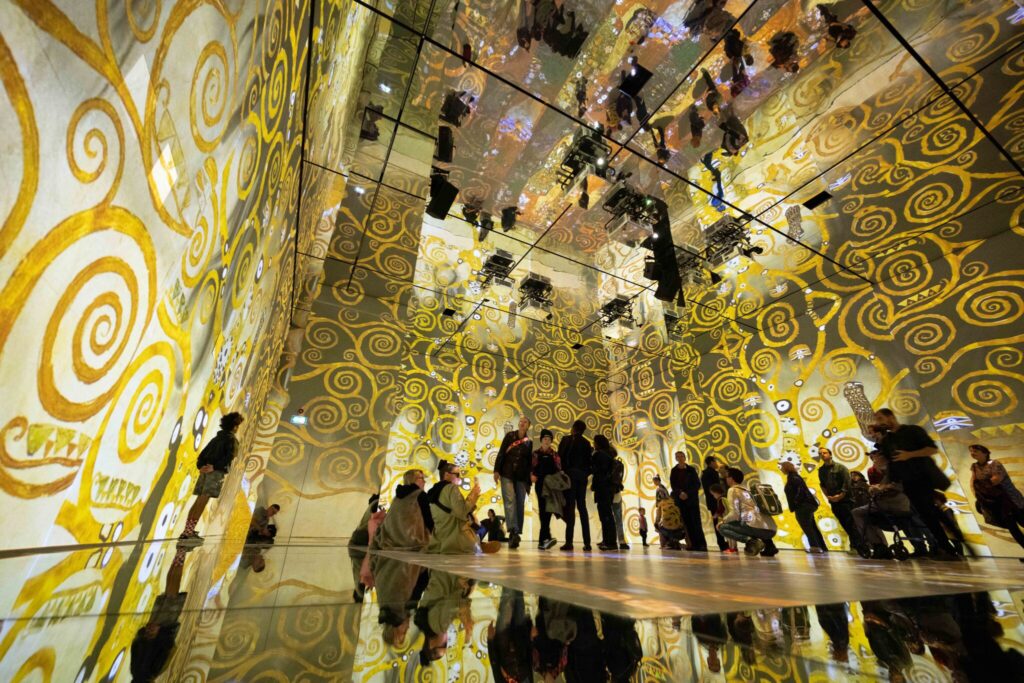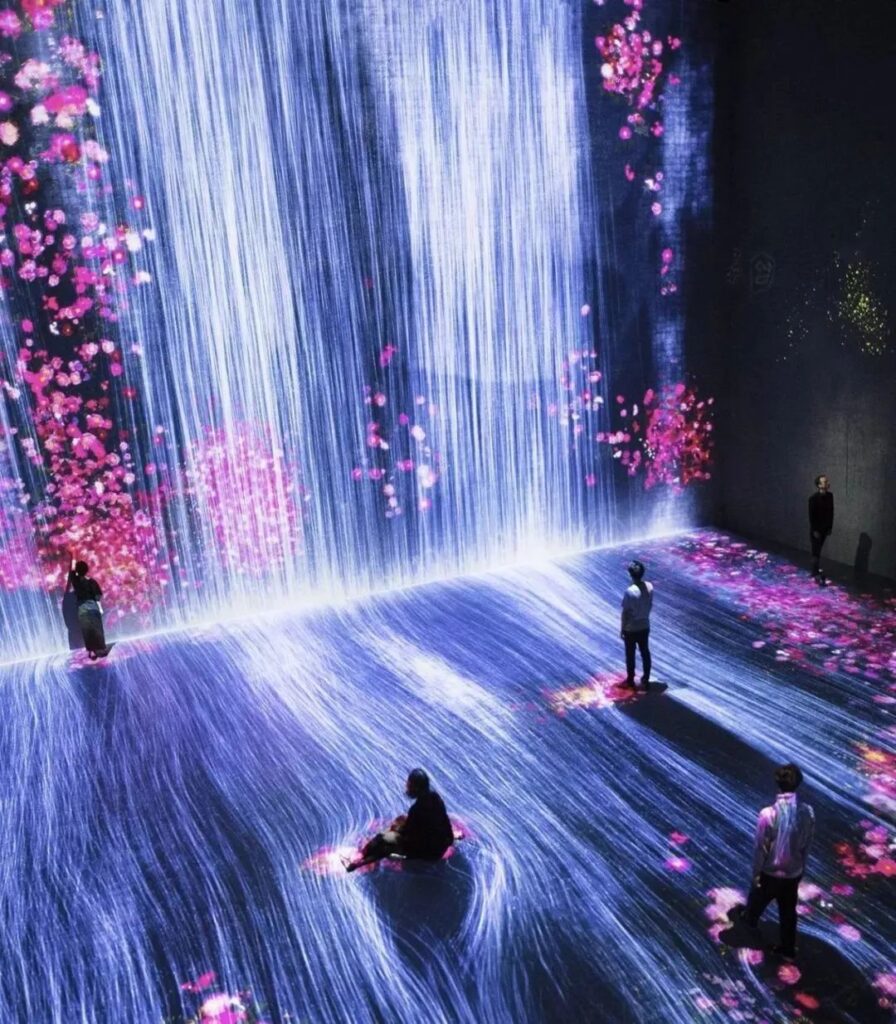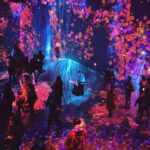1. Learning from the Frameless Exhibition (London)
The Frameless Exhibition in London is an interactive screen-based exhibition space that uses large-scale projections to create immersive environments. Unlike traditional exhibitions, where visitors are passive observers, Frameless invites movement-based interaction, allowing audiences to engage dynamically with projected artworks.
Adaptation for My Project:
✅ Consider using 360-degree projection mapping to envelop audiences in a cinematic world beyond the conventional screen.
✅ Explore motion-tracking technology, where audience movement influences the film’s visuals, similar to Frameless’ interactive projection spaces.

2. Interactive Narrative Inspiration: Black Mirror: Bandersnatch (Netflix)
One of the key inspirations for interactive storytelling is Black Mirror: Bandersnatch (2018), a Netflix film that allows viewers to make choices affecting the plot’s direction. This format aligns with my project’s vision of Expanded Cinema, where audiences become active participants rather than passive spectators.
Adaptation for My Project:
✅ Introduce decision-making points in the film screenings, where audiences collectively determine how the narrative unfolds.
✅ Use multiple endings to emphasize the agency of the audience, creating a non-linear, multi-perspective film experience.
3. Immersive Environments: teamLab’s Digital Art Spaces
The work of teamLab, a digital art collective, is another strong reference for my project. teamLab’s interactive digital installations create environments where audiences physically interact with projected visuals, breaking down the boundary between the digital and physical worlds.
Adaptation for My Project:
✅ Experiment with projection-responsive environments, where film narratives respond to audience movement, mirroring teamLab’s interactive digital spaces.
✅ Use sensor-based technology to allow participants to trigger visual or auditory changes within the cinematic experience.
🔗 teamLab

4. Theatrical Immersion: Punchdrunk’s Site-Specific Theatre
Punchdrunk, the company behind immersive productions like Sleep No More and The Burnt City, reimagines theatre by allowing audiences to move freely through multi-room environments, uncovering narratives at their own pace. This aligns with my project’s idea of cinema as a spatial journey rather than a fixed screen experience.
Adaptation for My Project:
✅ Design the exhibition as a multi-room cinematic experience, where audiences physically navigate different film sequences.
✅ Consider an actor-augmented experience, where live performers interact with visitors, blending film and theatre.
The peer review feedback has been crucial in refining the interactive aspects of my Expanded Cinema project. Drawing from Frameless, Black Mirror: Bandersnatch, teamLab, and Punchdrunk, I now have a clearer direction for integrating choice-based narratives, projection-mapped spaces, and immersive storytelling. Moving forward, I will incorporate these elements into both the conceptual development and practical execution of the exhibition.
Expanding the Theoretical Framework: Audience Agency & Digital Curation
The shift from traditional film curation to Expanded Cinema raises questions about how much agency should be granted to the audience. According to Bishop (2012), participatory art challenges conventional curator-artist-audience hierarchies but also risks creating the illusion of democratization rather than true engagement (Bishop, 2012).
One of the best examples of audience-driven narratives is Netflix’s Black Mirror: Bandersnatch (2018). This interactive film allows viewers to make real-time decisions, altering the storyline dynamically. However, despite offering multiple pathways, the film’s choices are still pre-programmed, demonstrating a paradox: is audience participation truly unrestricted, or is it an illusion carefully curated by creators?
This dilemma mirrors the challenges of Expanded Cinema exhibitions:
📌 How do we ensure audience agency while maintaining curatorial vision?
📌 Can AI-driven storytelling balance control and unpredictability?
Case Study: TeamLab Borderless – Digital Immersion & Curatorial Control
Case Study Introduction:
TeamLab Borderless, a pioneering digital art museum in Tokyo, utilizes projection mapping, motion sensors, and AI-driven interactivity to create a fully immersive experience. Unlike traditional exhibitions where audiences passively observe artworks, TeamLab dissolves the boundary between the observer and the artwork—for example, digital flowers bloom or wither based on human touch, and virtual pathways shift dynamically in response to visitor movement.
This interactive model challenges traditional curation by giving audiences agency to shape the experience rather than just interpret it.
This mirrors my project’s goal: to explore whether projection and AI can transform Expanded Cinema into a participatory experience, where audiences ‘edit’ the film in real time.
Conclusion: Refining the Balance Between Interaction and Curation
Through peer review, tutorial discussions, and case studies, I have explored the complexities of participatory Expanded Cinema, identifying both its potential and its challenges. While technology enhances audience engagement, it simultaneously raises curatorial and ethical dilemmas regarding control, agency, and authorship. The paradox of audience participation—whether it is truly open-ended or subtly pre-curated—remains a key issue in my research.
Moving forward, I will focus on:
✅ Integrating AI and real-time storytelling into Expanded Cinema while maintaining a structured curatorial vision.
✅ Defining the balance between curatorial authorship and audience-driven narratives to avoid the illusion of agency.
✅ Developing practical exhibition models that optimize interactivity without compromising meaning.
By addressing these questions, I aim to refine the next phase of my project, ensuring that Expanded Cinema is not only immersive and participatory but also cohesively curated and conceptually impactful.
Case Study & References
1. Bishop, C. (2012). Artificial Hells: Participatory Art and the Politics of Spectatorship. Verso.
2. Frameless Exhibition London. (n.d.). Available at: https://frameless.com
3. Netflix (2018). Black Mirror: Bandersnatch. Available at: https://www.netflix.com
4. teamLab Borderless. (n.d.). Available at: https://www.teamlab.art
5. Punchdrunk. (n.d.). Immersive Theatre & Site-Specific Performances. Available at: https://www.punchdrunk.com
6. teamLab (2018). Universe of Water Particles on Au-delà des limites. Available at: https://www.sohu.com/a/247178891_721246







